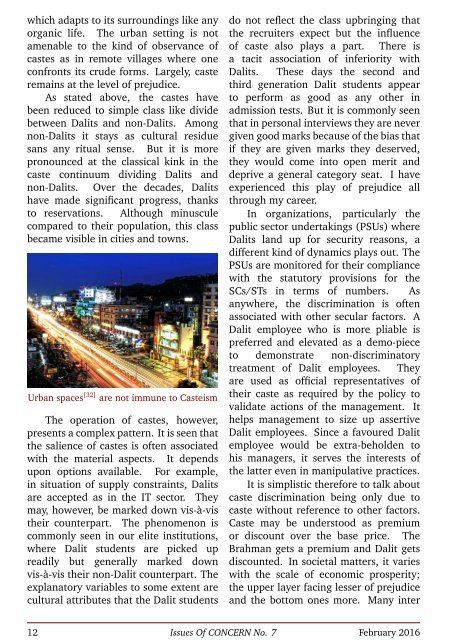ISSUES OF CONCERN
Issues_of_Concern_February_2016
Issues_of_Concern_February_2016
Create successful ePaper yourself
Turn your PDF publications into a flip-book with our unique Google optimized e-Paper software.
which adapts to its surroundings like any<br />
organic life. The urban setting is not<br />
amenable to the kind of observance of<br />
castes as in remote villages where one<br />
confronts its crude forms. Largely, caste<br />
remains at the level of prejudice.<br />
As stated above, the castes have<br />
been reduced to simple class like divide<br />
between Dalits and non-Dalits. Among<br />
non-Dalits it stays as cultural residue<br />
sans any ritual sense. But it is more<br />
pronounced at the classical kink in the<br />
caste continuum dividing Dalits and<br />
non-Dalits. Over the decades, Dalits<br />
have made significant progress, thanks<br />
to reservations. Although minuscule<br />
compared to their population, this class<br />
became visible in cities and towns.<br />
Urban spaces [32] are not immune to Casteism<br />
The operation of castes, however,<br />
presents a complex pattern. It is seen that<br />
the salience of castes is often associated<br />
with the material aspects. It depends<br />
upon options available. For example,<br />
in situation of supply constraints, Dalits<br />
are accepted as in the IT sector. They<br />
may, however, be marked down vis-à-vis<br />
their counterpart. The phenomenon is<br />
commonly seen in our elite institutions,<br />
where Dalit students are picked up<br />
readily but generally marked down<br />
vis-à-vis their non-Dalit counterpart. The<br />
explanatory variables to some extent are<br />
cultural attributes that the Dalit students<br />
do not reflect the class upbringing that<br />
the recruiters expect but the influence<br />
of caste also plays a part. There is<br />
a tacit association of inferiority with<br />
Dalits. These days the second and<br />
third generation Dalit students appear<br />
to perform as good as any other in<br />
admission tests. But it is commonly seen<br />
that in personal interviews they are never<br />
given good marks because of the bias that<br />
if they are given marks they deserved,<br />
they would come into open merit and<br />
deprive a general category seat. I have<br />
experienced this play of prejudice all<br />
through my career.<br />
In organizations, particularly the<br />
public sector undertakings (PSUs) where<br />
Dalits land up for security reasons, a<br />
different kind of dynamics plays out. The<br />
PSUs are monitored for their compliance<br />
with the statutory provisions for the<br />
SCs/STs in terms of numbers. As<br />
anywhere, the discrimination is often<br />
associated with other secular factors. A<br />
Dalit employee who is more pliable is<br />
preferred and elevated as a demo-piece<br />
to demonstrate non-discriminatory<br />
treatment of Dalit employees. They<br />
are used as official representatives of<br />
their caste as required by the policy to<br />
validate actions of the management. It<br />
helps management to size up assertive<br />
Dalit employees. Since a favoured Dalit<br />
employee would be extra-beholden to<br />
his managers, it serves the interests of<br />
the latter even in manipulative practices.<br />
It is simplistic therefore to talk about<br />
caste discrimination being only due to<br />
caste without reference to other factors.<br />
Caste may be understood as premium<br />
or discount over the base price. The<br />
Brahman gets a premium and Dalit gets<br />
discounted. In societal matters, it varies<br />
with the scale of economic prosperity;<br />
the upper layer facing lesser of prejudice<br />
and the bottom ones more. Many inter<br />
12 Issues Of <strong>CONCERN</strong> No. 7 February 2016


